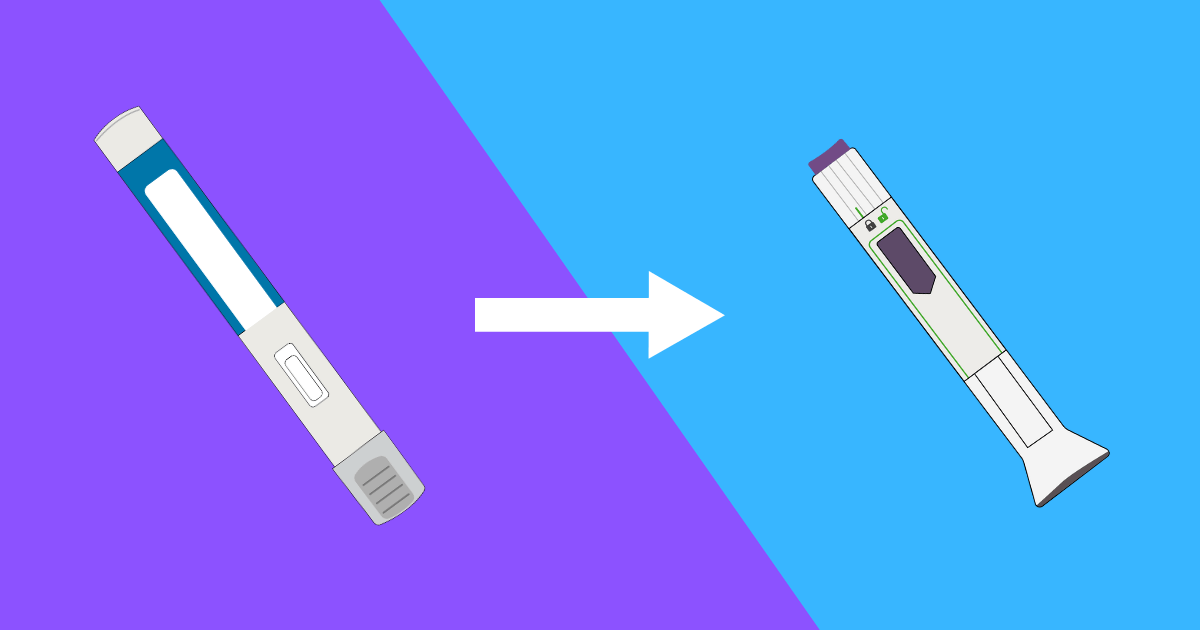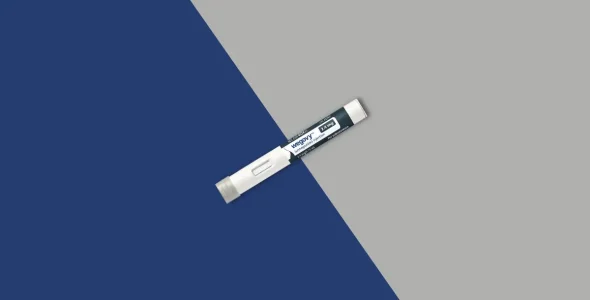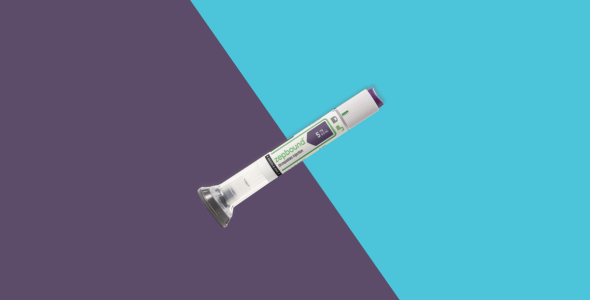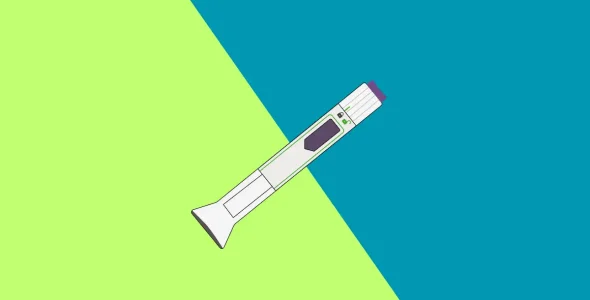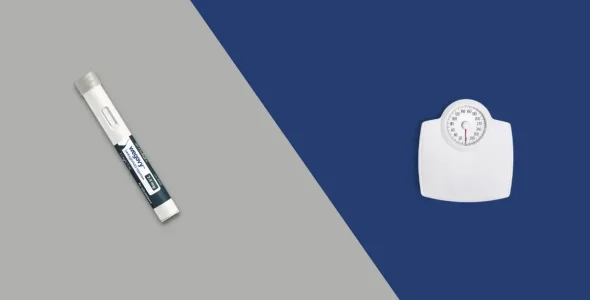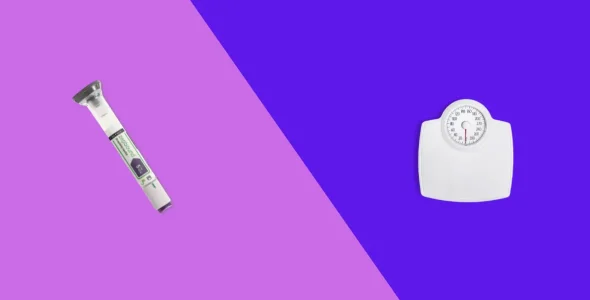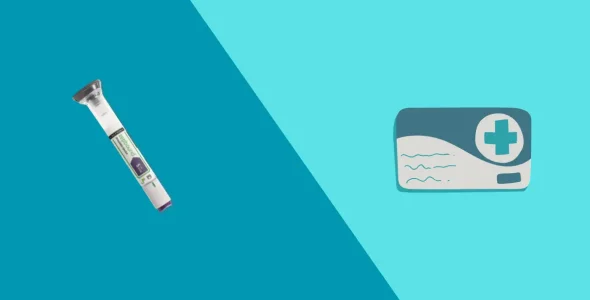Switching from Wegovy to Zepbound dose conversion chart
Ready to take your weight loss journey to the next level? Learn how to seamlessly switch from Wegovy to Zepbound with our easy-to-use dose conversion chart.
Key highlights
- Wegovy (semaglutide) is a GLP-1 receptor agonist and Zepbound (tirzepatide) is a GLP-1/GIP receptor agonist. Both medications are approved for chronic weight management.
- Zepbound demonstrates greater weight loss compared to Wegovy because of its dual action on GLP-1 and GIP receptors.
- There is no official direct conversion chart between these medications due to different dosage strengths and mechanisms of action. However, suggested equivalent dosages may help determine the right dosage when switching medications.
- It is not recommended to switch medications or dosages on your own, as incorrect doses can cause severe side effects and reduce the efficacy of drugs. Always consult a healthcare professional when switching medications or dosages.
- Understand the differences between Wegovy vs. Zepbound mechanism of actions and side effects before switching medications.
- Schedule follow-up visits with your healthcare provider to monitor your progress after switching medications so they can adjust the treatment plan as needed.
Wegovy and Zepbound are popular weight loss injections used for chronic weight management in adults with obesity and overweight. Wegovy’s active ingredient is semaglutide, a GLP-1 receptor agonist. Zepbound’s active ingredient is tirzepatide, a dual agonist at GLP-1 and GIP receptors. Both medications are approved by the U.S. Food and Drug Administration (FDA) for chronic weight management with increased exercise and a low-calorie diet.
As weight-loss medications evolve, many patients wonder about switching from Wegovy to Zepbound due to the higher efficacy of Zepbound in weight loss. A head-to-head clinical trial on Wegovy vs. Zepbound demonstrates 47% greater relative weight loss effects with Zepbound than with Wegovy.
However, before choosing the right medication, it is important to determine which medication meets your body’s needs, has fewer side effects and higher efficacy, and how to switch medications safely. You will need a dosage conversion chart to ensure the correct dosage for effective weight management and it’s important to work closely with your healthcare provider when switching medications.
This article provides a comprehensive guide to safely switching from Wegovy to Zepbound, includes detailed dosage conversion charts, and guides you on minimizing the side effects while switching between these weight loss medications.
Understanding Wegovy and Zepbound
Before getting into details of how to switch from Wegovy to Ozempic, let’s explore how these medications work for weight loss, their mechanisms of action and side effects.
Wegovy
Wegovy (semaglutide) is a GLP-1 receptor agonist, meaning it mimics the effects of a natural hormone (glucagon-like peptide-1) that regulates appetite and blood sugar. Semaglutide is the active ingredient in Wegovy, which has 94% structural similarity to naturally occurring GLP-1 hormone.
Mechanism of action
Wegovy works by activating GLP-1 receptors in your body, which helps you lose weight in the following ways:
- Mimics the action of GLP-1 receptors in the hypothalamus (the hunger control center of the brain) and reduces hunger pangs.
- Improves insulin secretion from beta cells of the pancreas. Increased insulin secretion lowers blood sugar levels.
- It slows down the movement of food from your stomach to the small intestine. This slower gastric emptying helps you feel full longer and suppresses your appetite.
- Reduces glucagon production of alpha cells of the pancreas which promotes blood sugar control.
FDA-approved uses
Wegovy is FDA-approved for chronic weight management in patients with obesity (body mass index 30 kg/m² or greater) and overweight (body mass index 27 kg/m² or greater) with at least one weight-related condition such as high blood pressure (hypertension), type 2 diabetes, high cholesterol levels, and heart disease, when used as an adjunct to a healthy lifestyle, reduced-calorie diet, and exercise. It’s also FDA-approved for reducing the risk of major adverse cardiovascular events.
Dosage
Wegovy is an injectable medicine administered once weekly under the skin of your abdomen, upper arm, and thighs. The dosing schedule of Wegovy is as follows:
- Starting dose: 0.25 mg once weekly for the first 4 weeks
- Titration phase: 0.5 mg once weekly for the next 4 weeks and then, if tolerated, 1 mg weekly for the next 4 weeks
- Maintenance dose for long-term weight management: If further weight management is needed, your prescriber will increase the dosage to 1.7 mg once weekly for the next 4 weeks
- Maximum dose: 2.4 mg once weekly
Efficacy
A clinical study shows that Wegovy (2.4 mg once weekly) decreased 10-15% of body weight compared to 2-3% with placebo.
Clinical trials have shown that a weekly injection of 2.4 mg Wegovy reduces the risk of cardiovascular events such as stroke and heart attack in patients with type 2 diabetes and decreases the incidence of death from cardiovascular causes. These studies show that Wegovy also has several cardiovascular benefits.
Potential side effects
Generally, Wegovy has mild side effects such as nausea, diarrhea, vomiting, constipation, and gastrointestinal problems. Severe side effects include changes in vision, pancreatitis, gallbladder problems, hypoglycemia, and allergic reaction to the medication.
Limitations
Wegovy should not be used in patients with a history or family history of thyroid cell tumors (MTC) and endocrine cancers (MEN 2 syndrome). It should also not be used in women who are pregnant, planning on becoming pregnant, or breastfeeding.
Zepbound
Manufactured by Eli Lilly, Zepbound has the active ingredient tirzepatide, which acts as a dual agonist at GIP and GLP-1 receptors. Both glucagon-like peptide-1 hormones and glucose-dependent insulinotropic peptide regulate appetite and increase insulin release after food intake.
Mechanism of action
Zepbound works as a dual GIP and GLP-1 receptor agonist, potentially offering greater efficacy for weight loss. The combined agonism at these receptors helps suppress appetite, promote insulin release, decrease glucagon secretions, delay gastric emptying and give you a feeling of fullness or satiety for a longer time. These effects promote weight loss and reduce food intake.
FDA-approved uses
Zepbound is FDA-approved for chronic weight management and treatment of moderate to severe obstructive sleep apnea (OSA) in patients with obesity (body mass index (BMI) of 30 kg/m² or higher) and overweight (BMI of 27 or higher) with at least one weight-related condition that is caused or worsened by being overweight. These conditions include diseases such as hypertension (high blood pressure), diabetes, and sleep apnea.
Tirzepatide is also approved for adults with type 2 diabetes under the brand name Mounjaro.
Dosage
Zepbound is administered once weekly subcutaneously (under the skin) of your abdomen (stomach), upper arm, and thighs.
The standard Zepbound dosage schedule is as follows:
- Starting dose: 2.5 mg once weekly for the first 4 weeks
- Titration phase: 5 mg once weekly for the next 4 weeks and then, if tolerated, the dosage may be increased in 2.5 mg increments every 4 weeks
- Maintenance dose for long-term weight management: 5 mg, 10 mg, or 12 mg once weekly
- Maximum dose: 15 mg once weekly
Efficacy
Zepbound is effective for the management of chronic weight and obstructive sleep apnea. A SURMOUNT-1 clinical trial demonstrates that 91% of participants (15 mg of tirzepatide once weekly) lost an average of 22.5% of their body weight, compared to 3.1% of the body weight in the placebo group after 72 weeks.
A phase 3 clinical trial compared the effect of Zepbound for the treatment of moderate-to-severe OSA and obesity versus placebo. The trial shows that Zepbound reduced breathing disruptions by 25-29 per hour, in comparison, placebo reduced breathing disruptions by only 5 per hour.
Side effects
The common side effects of Zepbound are similar to Wegovy. These include nausea, diarrhea, vomiting, and gastrointestinal issues. Serious side effects are inflammation of the pancreas, gallbladder stones, diabetic retinopathy, low blood sugar levels, and allergic or hypersensitivity reactions.
Limitations
Zepbound should not be used in patients with a history or family history of thyroid cell tumors (MTC) and endocrine cancers (MEN 2 syndrome). It should also not be used in women who are pregnant, planning on becoming pregnant, or breastfeeding.
Why switch from Wegovy to Zepbound
Your healthcare provider may decide to switch you from Wegovy to Zepbound based on your body’s tolerance and response to the medication and treatment goals.
Some people may not experience sufficient weight loss with Wegovy and Zepbound may offer more significant weight loss potential.
While Wegovy is generally well-tolerated, it can cause uncomfortable side effects. As Zepbound contains a different active ingredient, some people may respond differently to the medication. Keep in mind that Zepbound also causes similar gastrointestinal-related side effects for most people.
If you do not see a significant difference with Wegovy or experience side effects, switching to Zepbound may provide better tolerance and more significant weight loss results.
Better weight loss results with Zepbound
Based on clinical trial data, Zepbound is more effective and has greater potential for weight loss in comparison to Wegovy.
A SARMOUNT-5 clinical study shows that Zepbound led to an average of 20.2% weight loss. In comparison, Wegovy showed an average of 13.7% weight loss over 72 weeks.
Additionally, 31.6% of Zepbound participants lost 25% of body weight compared to 16.1% of participants who used Wegovy.
Improved blood sugar control with Zepbound
Zepbound has greater potential for managing blood sugar management in individuals with type 2 diabetes as compared to Wegovy. A clinical trial shows that tirzepatide (Zepbound) reduced mean daily 2-hour postprandial blood sugar levels by 4 to 4.5 mmol per litre, while semaglutide (Wegovy) reduced by 3.7 mmol per litre when combined with regular exercise and reduced calorie diet over 40 weeks.
Side effects tolerance issues with Wegovy
Wegovy and Zepbound have similar side effects like nausea, vomiting, diarrhea, and gastrointestinal problems. If you experience side effects with one medication, you might show better tolerance and fewer side effects with the other one. Everyone responds differently to medications.
If you notice side effects with any of these medications, speak with your doctor and discuss switching the medication.
Insurance and cost considerations
Wegovy is more expensive than Zepbound. Wegovy costs around $1,349 per month. The list price for Zepbound pens is $1,086 per month.
LillyDirect offers single-dose vials (2.5 mg and 5 mg) for $399 and $549 per month, respectively.
Most insurance companies do not cover weight loss medications. Check with your insurance provider for specific coverage details. Not all insurance providers recognize the benefits of medical weight loss.
Novo Nordisk has a Wegovy Savings Card. You could pay as low as $0 if you have commercial insurance that covers Wegovy. Otherwise, you may be able to pay as low as $499 per month if your commercial insurance doesn’t cover Wegovy or if you are uninsured.
Eli Lilly offers a Zepbound Savings Card. If you are commercially insured with coverage for Zepbound, you could pay as little as $25 per month for Zepbound. If your commercial insurance doesn’t cover Zepbound, you could save up to $469 per month.
Both medications’ savings card programs exclude people with government-sponsored insurance (like Medicare, Medicaid, Tricare, VA, etc) and require a valid prescription with FDA-approved labeling (e.g. chronic weight management). You must also be a U.S. citizen or legal resident. To check eligibility, visit the manufacturer’s savings card websites for more information.
Who should not switch to Zepbound?
Patients with a history of thyroid tumors such as medullary thyroid carcinoma (MTC) and MEN 2 syndrome (multiple endocrine neoplasia type 2 syndrome) should not take Zepbound.
Wegovy vs. Zepbound: key differences
There are several key differences between Wegovy and Zepbound:
Wegovy vs. Zepbound comparison
| Wegovy | Zepbound | |
|---|---|---|
| Active ingredient | Semaglutide | Tirzepatide |
| Mechanism of action | GLP-1 receptor agonist that boosts insulin release and supresses appetite | GLP-1 and GIP receptor agonist that boosts insulin release, reduces hunger, and promotes satiety |
| FDA-approvals | Chronic weight management in adults with obesity (BMI 30 kg/m² and greater) and overweight (BMI 27 kg/m² and greater) with at least one weight-related health condition | • Chronic weight management in patients with obesity and overweight with at least one weight related health condition • Management of moderate to severe obstructive sleep apnea (OSA) |
| Administration | Subcutaneous injection once weekly | Subcutaneous injection once weekly |
| Available strength | 0.25 mg, 0.5 mg, 1 mg, 1.7 mg, 2.4 mg | 2.5 mg, 5 mg, 7.5 mg, 10 mg, 12.5 mg, 15 mg |
| Dosage form | injectable (pre-filled) | • Single-dose injection pens • Single dose vials (2.5 mg and 5 mg) |
| Dose | • Starting dose: 0.25 mg once weekly • Maintenance dose: 1.7 mg and 2.4 mg once weekly • Maximum dose: 2.4 mg once weekly | • Starting dose: 2.5 mg once a week • Maintenance dose: 5 mg, 10 mg and 15 mg once weekly • Maximum dose: 15 mg once weekly |
| Weight reduction (according to 72 week study) | Zepbound showed an average weight loss of 20.2% of body weight | Wegovy showed an average weight loss of 13.7% of body weight |
| Side effects (as observed in a 40 week study) | • Nausea (17% to 22%) • Diarrhea (13% to 16%) • Vomiting (6% to 10%) • Decreased appetite (7% to 9%) • Hypoglycemia was reported in 0.6%, 0.2%, and 1.7%, who received tirzepatide doses of 5 mg, 10 mg, and 15 mg, respectively | • Nausea (18%) • Diarrhea (12%) Vomiting (8%) • Decreased appetite (5%) • Hypoglycemia (0.4%) |
| Cost | $1,349 per month | $1,086 per month |
| Insurance | • If you have commercial insurance with coverage for Wegovy, you could pay as little as $0 per month • If you do not have insurance, OR your commercial insurance does not cover Wegovy, you could pay $499 per month for Wegovy | • If you have commercial insurance that covers Zepbound, you could pay as low as $25 for a 1-3 month supply of Zepbound • If you have commercial insurance but it does not cover Zepbound, you could pay as little as $650 for a 1-month supply of Zepbound |
Wegovy to Zepbound dose conversion chart
There is no direct conversion chart for switching from Wegovy to Zepbound due to differences in their mechanisms of action and the way they work in the body. Moreover, they have different dosing schedules and available dosage strengths, which makes it difficult to switch the medications directly.
To safely switch from Wegovy to Zepbound, consult a healthcare provider because incorrect dosage can cause severe side effects and reduce the efficacy of these medications. Your doctor will determine the titration schedule according to your previous Wegovy dosage, weight changes with Wegovy, your body’s tolerance, health status, comorbid health conditions, and treatment goals.
Generally, conversion between Wegovy and Zepbound follows these schedules:
Wegovy vs. Zepbound dose comparison
| Wegovy | Zepbound | |
|---|---|---|
| Doses | 0.25 mg, 0.5 mg, 1 mg, 1.7 mg, 2.4 mg once weekly | 2.5 mg, 5 mg, 7.5 mg, 10 mg, 12.5 mg, 15 mg once weekly |
| Starting dose | 0.25 mg once weekly for the first 4 weeks | 2.5 mg once weekly for the first 4 weeks |
| Titration schedule | • Weeks 5-8: 0.5 mg once weekly • Weeks 9-12: 1 mg once weekly • Weeks 13-16: If tolerated, increase to 1.7 mg once weekly • Weeks 17 and ongoing: If the dosage needs to be escalated further, increase to 2.4 mg once weekly | • Weeks 5-8: 5 mg once weekly • Weeks 9-12: 7.5 mg once weekly • Weeks 13-16: If tolerated, increase to 10 mg once weekly • Weeks 17-20: If the dosage needs to be escalated further, increase to 12.5 mg once weekly for 4 weeks • Weeks 21 and ongoing: If the dosage needs to be escalated further, increase to 15 mg once weekly |
| Maintenance dose | 1.7 mg and 2.4 mg once weekly | 5 mg, 10 mg, and 15 mg once weekly |
| Maximum dose | 2.4 mg once weekly | 15 mg once weekly |
Wegovy to Zepbound dose conversion
| Wegovy dose | Equivalent Zepbound dose |
|---|---|
| Wegovy 0.25 mg to 0.5 mg | Consider starting Zepbound at 2.5 mg once weekly |
| Wegovy 1 mg to 1.7 mg | Consider starting Zepbound at 5 mg once weekly |
| Wegovy 2.4 mg | Consider starting Zepbound at 7.5 mg or 10 mg once weekly |
Key considerations when switching to Zepbound
Dosage and administration
Wegovy and Zepbound have different dosing schedules. Wegovy dosage starts with 0.25 mg once weekly, while Zepbound starts with 2.5 mg once weekly.
Similarly, 2.4 mg is the maximum dosage for Wegovy, and 15 mg once weekly is the maximum dosage for Zepbound.
Due to these differences, there is no direct conversion between these medications. However, estimated dosage equivalents help your healthcare provider choose the right dosage for you if you are already taking Wegovy or Zepbound.
Timing the transition
You should wait for at least one week before starting the new medication. For example, if you took your last dosage of Wegovy on Friday, you should take Zepbound the next Friday or any day after that.
Potential side effects
Do not take these medications together which can cause hypoglycemia (low blood sugar levels). Monitor side effects such as nausea, vomiting, and diarrhea. These side effects usually subside over time as your body gets used to the medication. If the side effects do not subside over time or you experience serious side effects, speak with your doctor.
Cost and insurance coverage
Most companies do not provide coverage for weight loss drugs. However, the Wegovy saving offer and Zepbound saving card can make these medications affordable for eligible candidates. In contrast to the Zepbound Savings Card, the Wegovy Savings Card also has an option for those without insurance. Check with your insurance provider for specific coverage details.
Medical history
If you have any comorbid conditions, always mention them to your doctor because they will adjust the medication dosage accordingly. As well, discuss your medical history and current medications with your doctor before switching.
Individualized treatment goals
Discuss your treatment goals with your healthcare provider and get a personalized treatment plan according to your medical history, body weight, and health goals. If you have extreme obesity or obstructive sleep apnea (OSA), Zepbound may be a better option for you.
How to safely switch from Wegovy to Zepbound
When switching from Zepbound, you need to carefully plan with the help of your healthcare provider to ensure you get the maximum results while minimizing side effects. Here are some tips to safely switch these medications:
Consult with your healthcare provider
Consult with your healthcare provider and seek medical advice before making any changes to your current medication regimen.
If you have any comorbid conditions such as hypertension, heart disease, high cholesterol levels, liver or kidney disease, and type 2 diabetes, inform your doctor. Discuss your medical history and current medications with your doctor before switching.
Your doctor may adjust the dosage of Zepbound based on your previous dose of Wegovy and individual factors. They will monitor your weight loss progress closely and adjust the dosage accordingly. Additionally, they will monitor your body mass index (BMI), weight changes, blood sugar levels, and side effects to determine the optimal maintenance dosage and monitor for any necessary adjustments.
Monitor your progress
Keep track of your weight loss progress, blood sugar levels, and any side effects after switching. If you encounter any adverse events, report them to your doctor.
Monitoring and managing side effects
While switching medications, strictly follow your doctor’s guidance and continuously monitor your blood sugar levels. Take a reduced-calorie diet, increase physical activity, stay hydrated, continue with regular exercise, and follow your diet plan.
Follow up appointments
Regular follow-up appointments with your doctor are necessary to assess your response to Zepbound and make any necessary adjustments. Schedule follow-up appointments regularly to safely progress with your weight loss treatment.
Factors influencing dose conversion
The following factors influence dose conversion:
- Individualized treatment: The conversion recommendations provide general guidance, but dosage adjustments may be necessary based on your body’s response. Always follow the prescribed guidelines provided by your healthcare provider.
- Medical conditions: Certain medical conditions, such as type 2 diabetes, may require dosage modifications.
- Other medications: Certain medications such as sulfonylureas and insulin may interact with Zepbound as they also lower blood sugar levels. When used together, they require dosage adjustments.
- Weight loss history: Your previous weight loss experiences and tolerance to Wegovy can also influence the starting dose of Zepbound.
- Side effects: The presence and severity of side effects can also influence dosage adjustments. In case of severe side effects, your healthcare professional may advise you to take a low dose or delay dosage escalation.
- Monitoring: Your blood sugar levels may fluctuate when using these medications. Closely monitor weight changes and fluctuations in the blood glucose, and any potential side effects after switching.
- Gradual transition: When switching, take the new medication after at least 7 days. Start from a low dose and increase it gradually as instructed by your healthcare provider. Before increasing the dosage, use the existing dose for at least 4 weeks.
How to switch from Wegovy to Zepbound
| Days passed since last dose of Wegovy | When to start Zepbound dosage |
|---|---|
| 1 day | In 6 days |
| 2 days | In 5 days |
| 3 days | In 4 days |
| 4 days | In 3 days |
| 5 days | In 2 days |
| 6 days | In 1 day |
| 7 or more days | Today |
Potential risks and considerations
Switching from Wegovy to Zepbound may be associated with these potential risks:
- You may experience gastrointestinal issues because Zepound has an increased risk of gastrointestinal problems due to its dual mechanism of action
- Incorrect conversions can cause severe side effects such as hypoglycemia, gallbladder issues, and pancreatitis (inflammation of the pancreas)
- GLP-1 medications including Zepbound and Wegovy are not recommended during pregnancy, when planning to become pregnant, and when breastfeeding
- You may experience temporary fluctuations in weight and blood sugar levels
- Your healthcare insurance company may require a new prior authorization when switching medications or dosages
- If you experience severe side effects such as allergic reactions or glycemic coma due to incorrect dosage, immediately seek medical attention from a nearby medical facility
Tips for a safe and smooth transition
Keep a journal or tracking app to mention your medication dosages and any side effects you experience. Have open communication with your healthcare provider throughout the switching process to ensure your safety. Always follow the dosage schedule provided by your provider and do not attempt to change the dosage on your own. In case of any side effects, consult your healthcare provider.
In addition, have regular follow-up appointments with your doctor so they can monitor progress and adjust the treatment when needed.
Frequently asked questions
Is there a direct conversion chart for switching between the two medications?
There is no official direct conversion chart between Wegovy and Zepbound because of their different mechanisms of action, dosing schedules, and available strengths. We have provided a dose conversion chart for reference purposes only.
How long will it take to see results after switching to Zepbound?
Zepbound reaches its maximum levels within 8-72 hours. However, it may suppress appetite the same day it is administered. You may notice weight changes after 4 weeks. A clinical study demonstrates that Zepbound shows weight changes at weeks 4, 12, and 24. The participants in the clinical trial experienced more significant weight loss over time.
Why is there no direct conversion chart?
There is no direct conversion chart between Wegovy and Zepbound due to the different mechanisms of action of both drugs, available strengths, and dosing schedules.
What should I do if I experience side effects after switching to Zepbound?
Mild side effects such as nausea, vomiting, and diarrhea usually subside over time. Staying hydrated, eating a healthy diet, and lifestyle modifications can be helpful. In case of severe side effects, consult your healthcare professional. They may adjust the dosage of the medication.
Can I switch back to Wegovy if Zepbound doesn’t work for me?
You can switch back to Wegovy if Zepbound does not suit you, but do not try to change medications on your own. Speak with your healthcare provider to safely switch back. Additionally, do not switch between medications immediately. Wait for at least one week before changing the medication. Your provider will help guide you through this process.
Can you take Wegovy and Zepbound together?
No, these medications cannot be taken together. They lower blood sugar levels and suppress appetite. Taking these medications together can cause severe side effects such as hypoglycemia (low sugar levels) and gastrointestinal problems.
Can I switch directly from Wegovy 2.4 mg to Zepbound 15 mg?
No, start low and titrate the dosage over time to minimize the side effects following your healthcare provider’s instructions.
Are Wegovy and Zepbound interchangeable?
No, Wegovy and Zepbound have different mechanisms and dosing schedules. They cannot be interchanged directly.
How long does it take to adjust to Zepbound after Wegovy?
It varies from person to person. It can take anywhere from 4–8 weeks for a full transition.
Can I switch directly from Wegovy to Zepbound?
No, these medications have different mechanisms of action and dosage strengths. You cannot switch directly from Wegovy to Zepbound.
Is Zepbound more effective than Wegovy?
A SARMOUNT-5 clinical trial shows that Zepbound is more effective than Wegovy for weight loss and blood sugar control. Zepbound showed 47% greater relative weight loss than Wegovy.
Will my insurance cover Zepbound?
Zepbound’s insurance coverage depends on your insurance provider. Most insurance plans do not cover weight loss medication, but some plans may cover it. It’s more likely to obtain coverage if prescribed Zepbound for obstructive sleep apnea (OSA). Contact your insurance company for coverage details.
What should I do if I miss a dose?
If 96 hours or 4 days have passed since the missed dose, skip the dose and take the next one on the regularly scheduled day. If less than 4 days have passed, take the missed dose as soon as you remember and the next dose on a regularly scheduled day.
Bottom line
If you plan to switch from Wegovy to Zepbound, remember there is no direct conversion between these medications. Both medications have different strengths, mechanisms of action, and dosage schedules. Equivalent dosage charts can help determine the right dosage. However, these charts provide a general guideline; the dosage is adjusted by healthcare professionals for each individual.
Several factors affect dosage conversion, such as an individual’s tolerance to the medication, side effects, previous dose of Wegovy, previous weight loss history, body weight, comorbid conditions, interaction with other medications, and treatment goals.
Before making any changes to your dosage schedule, speak with your healthcare provider to ensure your smooth transition from Wegovy to Zepbound for your weight loss journey.

